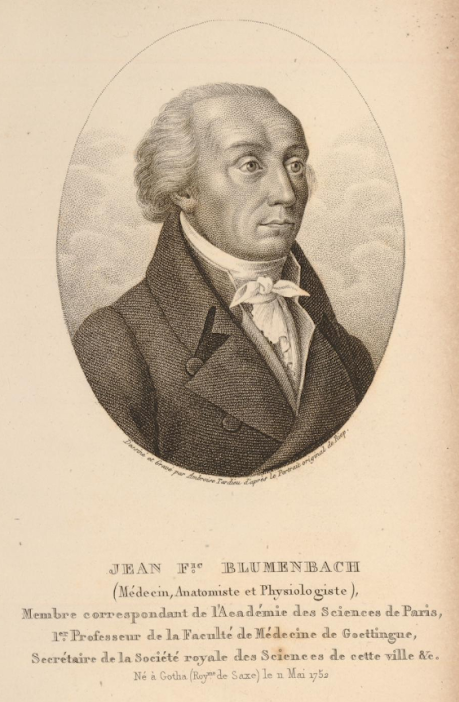http://www.blumenbach-online.de/index.php?id=2&L=1
Augstine, Hanna (Franziska) ed. Race: The Origins of an Idea (Bristol, UK: Thoemmes Press, 1996)
Bendyshe, Thomas, ed. Anthropological Treatises of Blumenbach and Hunter (London: Longman, et al., 1865)
Biskup, Thomas, “The University of Göttingen and the Personal Union.” in Brandan Simms, ed. The Hanoverian Dimension in British History, 1714–1837. (Cambridge, UK: Cambridge University Press, 2007)
Blumenbach online 2019. Blumenbach’s private library, “Transcription of SUB Göttingen, Cod. Ms. Blumenbach I, No. 4, p. 25-26,” (accessed 2019)
Blumenbach, Johann. De generis humani varietate nativa liber (Göttingen: Vandenhoeck, 1776)
Blumenbach, Johann. Handbuch der Naturgeschichte (Göttingen: Johann Christian Dieterich, 1779)
Blumenbach, Johann. De generis humani varietate nativa liber, 2nd ed. (Göttingen: Vandenhoek, 1781)
Blumenbach, Johann. “Einige naturhistorische Bemerkungen bey Gelegenheit einer Schweizerreise,” Magazin für das Neueste aus der Physik und Naturgeschichte 6 (1787): 1–12
Blumenbach, Johann. “Observations on Some Egyptian Mummies Opened in London,” Philosophical Transactions of the Royal Society of London 84 (1794): 177–195
Blumenbach, Johann. De generis humani varietate nativa, 3rd ed. (Göttingen: Vandenhoek et Ruprecht, 1795)
Blumenbach, Johann. Abbildungen naturhistorischer Gegenstände, 1tes Heft, Nro 1–10. (Göttingen: Johann Christian Dieterich, 1796)
Blumenbach, Johann. Observations on the Bodily Conformation and Mental Capacities of the Negroes. Philosophical Magazine 3 (1799): 144–147
Blumenbach, Johann. Beyträge zur naturgeschichte, Erster Theil, Zweyte Ausgabe (Göttingen: Heinrich Dieterich, 1806)
Blumenbach, Johann. [Report about Jo. Frid. Blumenbachii decas tertia collectionis suae craniorum diversarum gentium illustrata (1795)], Göttingische Anzeigen von gelehrten Sachen 1795 (60. Stück, 3. April): 601–604
Blumenbach, Johann. [Review of The interesting narrative of the life of Olaudah Equiano, or Gustavus Vassa, the African / written by himself (1789)], Göttingische Anzeigen von gelehrten Sachen 1790 (67. Stück, 26 April): 674–678
Brace, C. Loring. “Race” is a Four-Letter Word (New York: Oxford University Press, 2005)
Brace, C. Loring and Hunt, Kevin. “A nonracial craniofacial perspective on human variation: A(ustralia) to Z(uni),” American Journal of Physical Anthropology 82 (1990): 341–360
Carretta, Vincent. Equiano, the African: Biography of a Self-made Man (Athens, GA: University of Georgia Press, 2005)
Curtin, Phillip. The Image of Africa: British Ideas and Action, 1780–1850, Vol. 1. (Madison, WI: University of Wisconsin Press, 1964)
Eigen, Sarah. “Self, Race, and Species; J. F. Blumenbach’s Atlas Experiment,” The German Quarterly 78 (2007): 277–299
Equiano, Olaudah (Gustavus Vassa) 1794. The Interesting Narrative of the Life of Olaudah Equiano: Or Gustavus Vassa, the African, 9th Ed. (London: Olaudah Equiano, 1794)
Flourens, Jean Pierre. Éloge historique de J. Fr. Blumenbach (Paris: Didot, 1847)
Gascoigne, John. Joseph Banks and the English Enlightenment: Useful Knowledge and Polite Culture (Cambridge: Cambridge University Press, 1994)
Grégoire, Henri. De la littérature des négres (Paris: Chez Maradan, 1808)
Gruber, Johann. Vorwort. Johann Blumenbach. Über die natürlichen Verschiedenheiten im Menschengeschlechte. Translated by Johann Gruber (Leipzig: Breitkopf und Härtel, 1798)
Klatt, Norbert. Kleine Beiträge zur Blumenbach-Forschung, Vol. 4. (Göttingen: Norbert Klatt, 2012)
Lieber, F., et al., eds. Encyclopaedia Americana, Vol. 5 (Philadelphia: Blanchard and Lea, 1857)
Livingstone, Frank and Dobzhansky, Theodosius. “On the Non-Existence of Human Races,” Current Anthropology 3 (1962): 279–281
Marx, Karl Friedrich Heinrich. Zum Andenken an Johann Friedrich Blumenbach. (Göttingen: Dieterichschen Buchhandlung 1840)
Marx, Karl Friedrich Heinrich. “Memoir of the Life and Writings of the Late Professor Blumenbach of Göttingen,” Edinburgh New Philosophical Journal 30 (1841a): 221–240
Marx, Karl Friedrich Heinrich 1841b. “Memoir of the Life and Writings of the late Professor Blumenbach of Göttingen, Continued, ” Edinburgh New Philosophical Journal 31 (1841b): 1–9
Michael, John. “Nuance Lost in Translation: Interpretations of J. F. Blumenbach’s Anthropology in the English Speaking World,” NTM Zeitschrift für Geschichte der Wissenschaften, Technik und Medizin, September 25, no 3 (2017): 281–309
Mikkelson, Jon, ed. Kant and the Concept of Race (Albany, NY: SUNY Press, 2013)
Montague, Ashley. The Genetical Theory of Race, and Anthropological Method. American Anthropologist 44 (1942): 369–375
Rupke, Nicolaas and Lauer, Gerhard. “Introduction: A Brief History of Blumenbach Representation,” in Rupke, N. and Lauer, G., eds., Johann Friedrich Blumenbach: Race and Natural History, 1750–1850 (London: Routledge, 2019), 3–17
Shields, John. Phillis Wheatley’s Poetics of Liberation (Knoxville, TN: University of Tennessee Press, 2008)
Smith, Justin. Nature, Human Nature, and Human Difference: Race in Early Modern Philosophy (Princeton, NJ: Princeton University Press, 2015)
Tiedemann, Friedrich. “On the Brain of the Negro, Compared with That of the European and the Orang-Outang.” Philosophical Transactions of the Royal Society of London 126 (1836): 497–527
Vermeulen, Hans. Before Boas: The Genesis of Ethnography and Ethnology in the German Enlightenment (Lincoln, NE: University of Nebraska Press, 2015)
Weir, William. “Recollections of a Göttingen Student, No. III: Blumenbach,” The Edinburgh Literary Journal 6 (1831): 111–113
